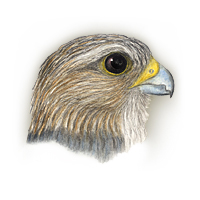|
Field
Guide IDs: BREEDING:
Open habitats,
nests primarily in open woodland, savanna; occ in
cities. 1 brood. DISPLAYS:
Pair perform aerial
acrobatics high over nest site. NEST:
Often use abandoned
nest of crows, magpies, hawks, occ relined with
twigs and feathers; also use tree cavity with
commanding view, cliff, or scrape on ground in
treeless country. EGGS:
White, marked with
reddish-brown, some nearly unmarked. 1.6" (40
mm). DIET:
Often >90%
birds. Rather than stooping, often take prey in
fast, low horizontal flight. CONSERVATION:
Winters s through
C.A., West Indies to n S.A. Blue List 1972-81,
Special Concern 1982-86; uncommon, status unclear.
Showing effects of pesticides in e Canada and of
mercury buildup in w Canada. NOTES:
Male arrives on
breeding grounds before female, usu returning to
same area each year. Male does all of hunting from
courtship through incubation, occ through nestling
period. Yearlings, esp males, occ serve as helpers
in territory defense, feeding of female, etc.
Females take heavier prey than do males; seasonal
changes in diet correspond to prey availability.
Formerly known as Pigeon Hawk. Uncommon migrant
and winter visitor virtually throughout campus.
During winter, often seen perched conspicuously at
the tops of tall redwoods and eucalyptus trees or
in rapid pursuit of Mourning Doves, House Finches,
and other birds. .....Similar
Species: American
Kestrel ESSAYS: Size
and Sex in Raptors;
Raptor
Hunting;
Raptor
Conservation;
Cooperative
Breeding;
Metallic
Poisons;
DDT REFERENCES:
Becker, 1985; Cade,
1982; Cramp and Simmons, 1980; James and Oliphant,
1986; Newton et al., 1984. |
